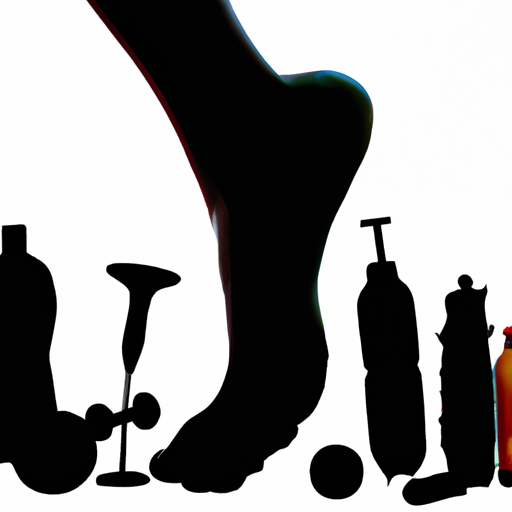Flat feet, medically known as pes planus, is a condition that affects millions of people worldwide. It occurs when the arches of the feet collapse, causing the entire sole to touch the ground. While some individuals with flat feet experience no discomfort or limitations, others may suffer from pain and difficulty with certain activities. In this article, we will delve into the various aspects of flat feet, including its causes, symptoms, and diagnosis. Additionally, we will explore the treatment options available, ranging from orthotics to physical therapy. Lastly, we will provide lifestyle tips and exercises that can help individuals with flat feet manage their symptoms effectively. Whether you have recently been diagnosed with flat feet or are simply curious about this common condition, read on to gain a comprehensive understanding of flat feet and how to best manage it.
1. Understanding Flat Feet: Causes, Symptoms, and Diagnosis
Flat feet, also known as fallen arches, is a common condition where the arches on the inside of the feet are flattened, causing the entire sole of the foot to touch the ground when standing. This condition can affect one or both feet and can be present from birth or develop over time. Understanding the causes, symptoms, and diagnosis of flat feet is essential for effective treatment and management.
The causes of flat feet can vary depending on the individual. In some cases, flat feet may be a result of genetics, where the arches fail to develop properly during childhood. This is known as congenital flat feet. Other causes include weak or stretched tendons, injuries to the foot or ankle, arthritis, obesity, and certain medical conditions such as diabetes or nerve disorders.
Symptoms of flat feet can range from mild to severe. Some individuals with flat feet may experience no pain or discomfort at all, while others may develop symptoms such as pain and swelling along the inside of the ankle, arch, or calf. The feet may also become tired easily, especially after prolonged periods of standing or walking. Some individuals may also experience difficulty in finding comfortable footwear or notice their feet turning outward when walking.
Diagnosing flat feet usually involves a thorough examination by a medical professional. The doctor will assess the patient’s medical history, including any previous injuries or medical conditions. They will also evaluate the patient’s feet and observe how they stand and walk. X-rays or other imaging tests may be ordered to assess the structure of the feet and rule out any underlying conditions or injuries.
It is important to note that having flat feet does not always require treatment. If the condition is not causing any pain or hindrance to daily activities, treatment may not be necessary. However, for those experiencing symptoms or discomfort, various treatment options are available.
Non-surgical treatments for flat feet often focus on relieving symptoms and improving foot function. This may include wearing supportive footwear with arch supports or orthotic inserts to provide extra stability and cushioning. Physical therapy exercises can also be beneficial in strengthening
2. Treatment Options for Flat Feet: From Orthotics to Physical Therapy
Flat feet, also known as fallen arches, can cause a variety of problems for individuals. Thankfully, there are several treatment options available to alleviate the symptoms and improve the condition of flat feet. From orthotics to physical therapy, individuals with flat feet have various options to explore.
Orthotics, or custom shoe inserts, are commonly prescribed for individuals with flat feet. These inserts are designed to provide support and stability to the arches of the feet. They can help distribute the body weight evenly, reducing strain on the feet and preventing foot pain. Orthotics can be particularly beneficial for individuals who spend a significant amount of time on their feet or engage in activities that put extra stress on the feet, such as running or participating in high-impact sports.
Physical therapy is another effective treatment option for flat feet. A skilled physical therapist can develop a personalized treatment plan to strengthen the muscles and improve the flexibility of the feet and ankles. This may involve specific exercises and stretches that target the arches and surrounding muscles. Physical therapy can also help improve overall posture and body mechanics, which can further reduce pain and discomfort associated with flat feet.
In some cases, flat feet may require additional interventions, such as medications or surgery. Nonsteroidal anti-inflammatory drugs (NSAIDs) may be recommended to reduce pain and inflammation. Surgical options, although less common, may be considered for individuals with severe flat feet that do not respond to conservative treatments. Surgical procedures can involve repairing or reconstructing the tendons and ligaments in the feet to restore the arches.
It is important to note that treatment for flat feet should always be guided by a healthcare professional. They can accurately diagnose the condition and recommend the most suitable treatment options based on the individual’s specific needs and circumstances. Additionally, healthcare professionals can provide valuable advice on footwear choices and lifestyle modifications that can help manage the symptoms of flat feet.
In conclusion, individuals with flat feet have a range of treatment options available to them. From orthotics to physical therapy, these interventions can help alleviate pain, improve foot function, and enhance
3. Living with Flat Feet: Lifestyle Tips and Exercises to Manage Symptoms
Living with flat feet can be challenging, but there are lifestyle tips and exercises that can help manage the symptoms associated with this condition. While flat feet may not always cause discomfort or require treatment, some individuals may experience pain, swelling, or difficulty with certain activities. Here are some practical strategies to incorporate into your daily routine to alleviate discomfort and improve your quality of life.
1. Wear supportive footwear: Investing in well-fitting shoes with good arch support is essential for individuals with flat feet. Look for shoes that provide stability and cushioning to minimize strain on the feet. Avoid high heels or shoes with minimal arch support, as they can aggravate symptoms.
2. Use orthotic inserts: Orthotic inserts are custom-designed shoe inserts that provide additional arch support and help distribute body weight evenly. These inserts are available over-the-counter or can be prescribed by a podiatrist. Using orthotics can significantly reduce pain and discomfort associated with flat feet.
3. Stretch and strengthen the feet: Regular stretching and strengthening exercises can help improve the flexibility and strength of the muscles and ligaments in the feet. Some effective exercises include calf stretches, toe curls, and towel scrunches. These exercises can be performed at home or under the guidance of a physical therapist.
4. Maintain a healthy weight: Excess weight can put additional stress on the feet and exacerbate flat foot symptoms. By maintaining a healthy weight through a balanced diet and regular exercise, you can reduce the strain on your feet and alleviate discomfort.
5. Choose low-impact exercises: Engaging in low-impact activities such as swimming, cycling, or using an elliptical machine can help minimize stress on the feet while maintaining overall fitness. These exercises provide cardiovascular benefits without putting excessive strain on the arches.
6. Rest and elevate your feet: If you experience pain or swelling, it is crucial to give your feet adequate rest. Elevating your feet above the level of your heart can help reduce swelling and promote blood circulation. Taking short breaks throughout the day to elevate your feet can provide relief and prevent worsening

